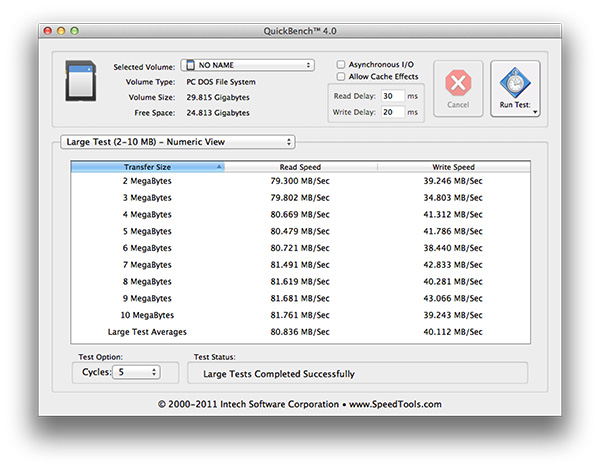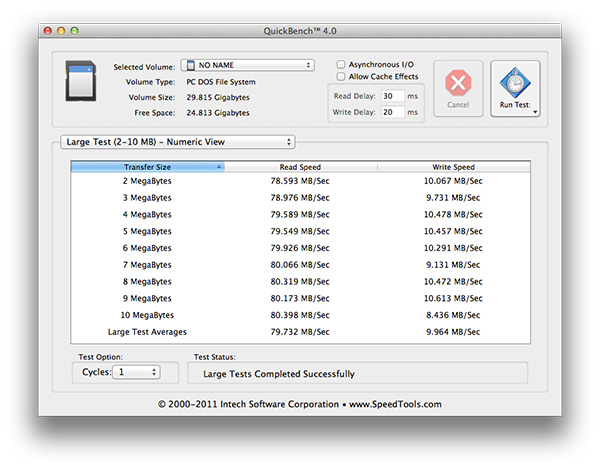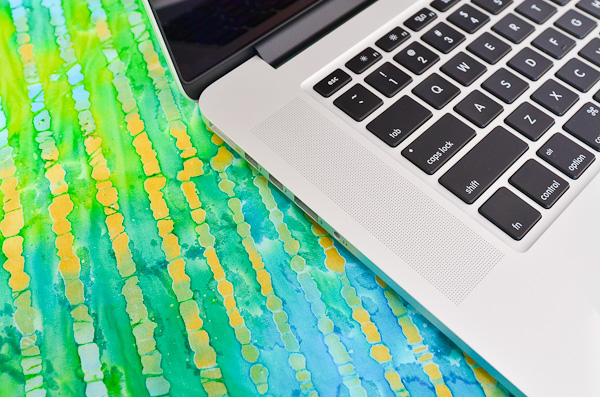The next-gen MacBook Pro with Retina Display Review
by Anand Lal Shimpi on June 23, 2012 4:14 AM EST- Posted in
- Mac
- Apple
- MacBook Pro
- Laptops
- Notebooks
WiFi Performance
The next-gen MacBook Pro is equipped with a decidedly this-gen wireless stack. In other words it uses the same 3x3:3 WiFi solution that was present in the 2011 MacBook Pro and is present in the non-Retina 2012 MacBook Pro as well: Broadcom’s BCM4331. The wireless behavior characteristics are a bit different since this is a physically different chassis, but we’re still dealing with a 3-stream 802.11n solution - not 802.11ac. All three antennas are located in the Retina Display’s housing.
We have seen Apple be conservative with component choices in the past. Deciding to stick with Samsung’s 45nm LP process for the A5X instead of embracing 32nm LP sooner with the 3rd gen iPad is one example that comes to mind. Like a good silicon company Apple appears to mitigate risk in design by sticking with known-good components wherever possible. Major changes to the industrial design are typically paired with comparatively minor silicon changes, and other components are kept as static as possible so long as they don’t overly compromise experience. While 802.11ac dongles and routers are just arriving today, Apple likely froze the Retina MBP’s wireless configuration quite a while ago. Rather than be caught shipping potentially unratified hardware, Apple went the safe route and stuck with 802.11n.

That’s not to say Apple’s wireless implementation is bad. The 15-inch MacBook Pro has been one of the best behaved notebooks on wireless that I’ve had the pleasure of using. The MacBook Pro with Retina Display is no different. Just like before, the best case negotiated physical rate is 450Mbps when paired with a 5GHz 3x3 access point. Unobstructed, within a couple of feet of the AP, I measured as much as 230Mbps to the Retina MacBook Pro. I tested at three different distances from the AP, through walls and on both 2.4GHz and 5GHz bands. Overall performance seemed comparable to the standard 15-inch MacBook Pro, although it’s definitely faster in some areas and slower in others.
| Location 1 | Location 2 | Location 3 | |
| 2011 MacBook Pro (2.4GHz) | 124.0 Mbps | 12.6 Mbps | 61.6 Mbps |
| Retina MacBook Pro (2.4GHz) | 117.9 Mbps | 87.6 Mbps | 44.0 Mbps |
| 2011 MacBook Pro (5GHz) | 186.8 Mbps | 154.6 Mbps | 24.7 Mbps |
| Retina MacBook Pro (5GHz) | 227.7 Mbps | 156.8 Mbps | 33.7 Mbps |
The second test location consistently performed poorly on the 2011 MBP, only on 2.4GHz however. For the most part there were no real surprises otherwise.
The SD Card Reader
It was our own Brian Klug who clued me into the horrible behavior of the 2011 MacBook Pro’s SD card reader. Depending on the SD card used, the integrated SD card reader either performed admirably or was the most frustrating part of the Mac experience. Out of the three SD cards I frequently use: a Patriot LX series card, a Transcend and a new UHS-I Patriot EP Pro, only the Transcend card actually works remotely well with the 2011 chassis. Even then, it’s not perfect. I usually have to insert and remove the card at least once before the reader will recognize it. The LX and EP Pro on the other hand are measurably worse. To get the EP Pro to work in the 2011 MBP’s reader I usually have to push the card in then apply upward or downward force to the exposed edge of the card to get it to read properly. Even then it’ll usually disappear from OS X or be present but read at bytes per second. I doubt this is the fault of the card itself but rather the latest example of incompatibility with the horrible SD card reader in last year’s MacBook Pro.
At least with the cards I’ve tested, the Retina MacBook Pro exhibits none of these issues. Over dozens of insertions I had no issues reading from or writing to all three of these cards, including the problematic ones. I ran a Quick Bench test on the EP Pro as it’s the fastest of the lot and came away with reasonable performance as well. Roughly 80MB/s reads and 40MB/s writes. The numbers are shy of Patriot’s 90/50 spec but quite good.
One of the times I was able to get the EP Pro working in the 2011 MacBook Pro I managed to squeeze in a single Quick Bench run. Read performance was almost identical at 80MB/s, but write performance was far lower at only 10MB/s:
Shortly after the test completed I could no longer write to the drive in the 2011 MBP so I suspect the card reader was acting up again. Needless to say, if you like using SD cards with your MacBook Pro the Retina Display model appears to be much better. That’s not to say there couldn’t be other incompatibilities, but in everything I tested it looks like this problem is finally fixed.
Better Speakers and Dual Mics
Apple is proud of its new speaker design in the Retina MacBook Pro. There’s not a whole lot you can do for tiny laptop speakers but despite shrinking the overall volume of the chassis, Apple has managed to deliver much better sound out of the new speakers in the rMBP. Like most of the upgrades to the next-gen MacBook Pro, you really need to do an A/B comparison to appreciate the difference. And keep your expectations in line with reality, a good set of external speakers are always going to sound better. With that said, the new speakers definitely deliver a fuller, more rich sound than their predecessor. You can still tell you’re listening to some form of integrated speakers, but now they sound distinctly less like they’re coming from a inside a notebook.
In preparation for Mountain Lion's arrival with dictation support, Apple outfitted the next-gen MacBook Pro with dual microphones in order to better focus on your spoken voice and not on background noise. In practice the new mics work reasonably well, rejecting moderate volume background noise. Loud music nearby will still cause interference and as always, accurate dictation requires more than just good quality source audio to get right.













471 Comments
View All Comments
orthorim - Wednesday, June 27, 2012 - link
First of all, PC manufacturers are followers.Second even if they wanted to do it, how are they going to get Microsoft to fully support retina mode? It's evident from the review that Apple's had to do a lot of work on the software side to make it work, and it's still not perfect.
That's Apple's huge advantage: They make hardware and software.
The obstacle for a PC manufacturer would be:
- Get retina displays in quantity (same issue Apple faces - it's doable but by no means easy)
- Get Windows to support retina mode - even if MS were willing, no one knows what amount of effort would be involved. I guess it would be extremely hard to do.
- Get gfx card manufacturers to optimize their drivers to it's fast
All of this takes time and effort...
PubFiction - Friday, August 3, 2012 - link
None of you get it.Super resolution is a by product of OLED. Not of apple, not of anyone else. LG says they can make a panel and apple pays the highest price to have exclusive access fo a while. Are you guys really so stupid that you think apple actually makes these panels?
IF LG does not push IPS displays down in price and up in resolution OLED is quickly going to supplant LCDs as the premium product.
Let me make it clear to the sheeple, PC companies do not give a shit about you or giving you bette stuff until it becomes neccessary to maintain their business, apple happily sold everyone TN panels with low resolution for years while PC makers were offering IPS, wide gamut in work stations laptops.
gorash - Saturday, June 23, 2012 - link
Come on, 1080p screens have existed for some time, and obviously it would move to 4k at some point when it's ready. From the performance standpoint, "Retina" doesn't seem to be all that ready. Maybe in the next year or so, it will be.OCedHrt - Saturday, June 23, 2012 - link
Although the reviewers at Anandtech didn't really like the Z, it is the best laptop I have used to date.solipsism - Saturday, June 23, 2012 - link
Even if Apple can these 27" IPS panels made at a reasonable price and quantity you still have to deal with rending all the pixels in a way that adds more pros than cons.Remember 4k is 4x the pixels of 1080p. Taking the 27" from 2560x1440 to 5120x2880 is going from 3,686,400 px to 14,745,600 px.
DeciusStrabo - Saturday, June 23, 2012 - link
4k isn't 4x the pixels of 1080p. 4k is QFHD, which is 3840x2160 (6.1 million pixels vs. 2 million in 1080p).However, since we already have a spec for 8K (7680x4320 ~ 33 million pixels) things to indeed get interesting soon.
lukarak - Saturday, June 23, 2012 - link
3840x2160 = 8,294,400/
1920x1080 = 2,073,600
--------------------------------
2 x 2 = 4
DanNeely - Saturday, June 23, 2012 - link
4k is a lot more than just quadHD. I wouldn't be surprised if that ends up being the dominant mass market version; but most current 4k cameras record video at 4096x2304/2160.Ohhmaagawd - Saturday, June 23, 2012 - link
"emember 4k is 4x the pixels of 1080p. Taking the 27" from 2560x1440 to 5120x2880 is going from 3,686,400 px to 14,745,600 px."I really doubt it needs to double to be "retina".
Not sure what the sweet spot is, but my gut is somewhere around 3500-4000 pixels wide.
Acanthus - Saturday, June 23, 2012 - link
Apple and their forward looking business sense = buying every factory in the world that can produce high dpi displays. (Yes, they really did that)Anticompetitive =/= "forward thinking"